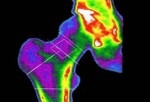 Researchers have found that hormone replacement therapy in young women with primary ovarian insufficiency (POI) led to increases in their bone mineral density, restoring levels to normal.
Researchers have found that hormone replacement therapy in young women with primary ovarian insufficiency (POI) led to increases in their bone mineral density, restoring levels to normal.
The findings provide important treatment information for women with POI and their physicians. Researchers at the NIH examined scans of the hip and lower spine to determine the effects of hormone treatment on bone mineral density of women with primary ovarian insufficiency.
Spontaneous POI, which affects 1 in 100 women by age 40, occurs when the ovaries stop producing sufficient estrogen in the absence of a known cause, such as anorexia, chromosome abnormality, or chemotherapy. It is typically characterized by irregular or absent menstrual cycles, hot flashes, and fertility problems. Women with POI have abnormally low levels of reproductive hormones, including estradiol, a type of estrogen produced by the ovary, as well as testosterone, a predominantly male hormone, but also produced by women in smaller amounts. They also have reduced bone mineral density, which can lead to osteoporosis and bone fractures.
“Bone mineral density is an important measure of bone health. This study showed that not only could hormone treatment reduce the rate at which women with POI lose bone mineral density, but it could actually restore bone density to normal levels,” said Dr. Lawrence M. Nelson, study author and investigator in the Program on Reproductive and Adult Endocrinology at NICHD.
The study was supported by the Eunice Kennedy Shriver National Institute of Child Health and Human Development (NICHD), part of the National Institutes of Health.
The findings were published online in the Journal of Clinical Endocrinology & Metabolism. To reach more, click HERE.
